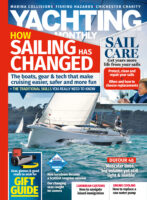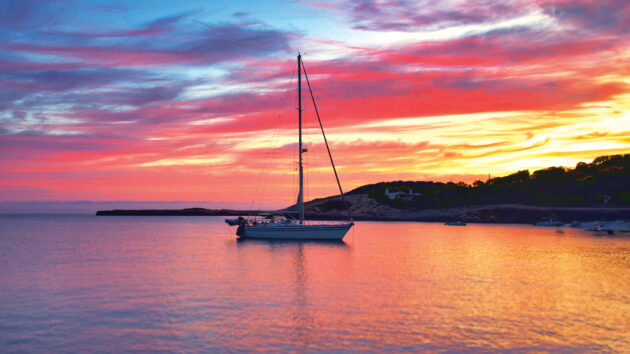One trip and James Kenning was smitten with Mallorca and the Spanish islands. Several years later, he returned with his own boat
Chartering a yacht out of Mahon back in 2014 was my first experience of the Balearics. With just a week onboard, we worked our way anticlockwise around Menorca and, in so doing, fell in love with the land, the climate, and the people. Since then it has long been a dream to return in my own boat to more fully explore all the islands of this self-contained cruising area.
With warm seas, dramatic scenery, fine beaches and sheltered anchorages, the Balearics is a spectacular cruising ground for boats bound for the western Mediterranean. Cities and towns that are packed with culture, and a good network of harbours and marinas, further add to the attraction of Ibiza, Formentera, Mallorca, and Menorca.
However, in many ways this island group has become a victim of its own success; the region has gained a reputation for being both crowded and costly for sailors. In high season especially, there can be intense competition for anchoring spots, not so much between cruising yachts, but from the proliferation of day charter boats. In addition, the rigidly enforced restrictions to protect the Posidonia seagrass fields add further fuel to the ‘race for space’ in the most popular locations.
For those wanting pontoon facilities, marina prices can be eye-wateringly high. All that said however, the Balearics really are too good an area to dismiss or pass by. With some cunning planning, careful preparation and inherent flexibility, the worst of the crowds can be avoided, budgets kept under control, and wonderful memories made.
As already hinted, our key strategy was to avoid the busiest months of summer and plan to cruise the shoulder months of May into July, and September into October. This raises the question of where to base for July and August. I chose to put Arkyla into Valencia which has a choice of two reasonably priced, and well protected marinas.
Marina de Valencia, developed around the facilities built for the 32nd Americas Cup, won my vote mainly upon its easy access to both the city and its beach. From Valencia it is a 14-hour sail to Ibiza, or a 24-hour passage to the north coast Mallorca. Other options on the mainland for basing your yacht include Cartagena, 135 miles to the southwest of Ibiza, or Barcelona, 105 miles north of both Menorca and Mallorca.
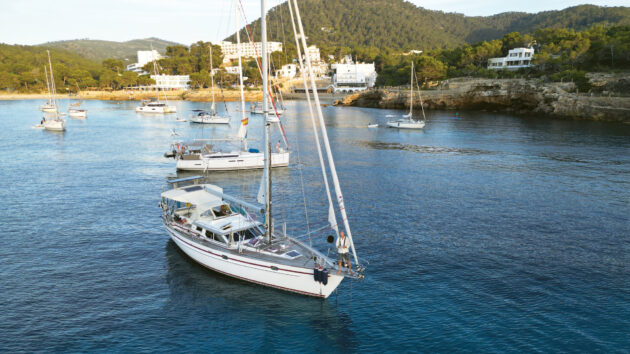
Portinatx is a popular anchorage and it can be hard to find a Posidonia-free spot to drop hook; Cala Xaracca 1 mile west, is an alternative, especially for a night arrival. Photo: James Kenning
Planning your landfall
When looking for landfall in the islands after a long passage, it is wise to aim for an anchorage that, as well as offering good protection, is likely to have sufficient hazard-free space to accommodate a potential late arrival if your passage takes longer than expected.
In delivering Arkyla from the Algarve in 2023, we pit-stopped in mainland Spain’s Cartagena to assess our options. My crew had a burning desire to revisit Espalmador, the unspoilt, but very popular, islet just north of Formentera. As it was still early season (late May) we decided now was the ideal time, so we planned our passage for an early morning arrival in the hope of securing a spot before the arrival of the day charters.
Later in the season, when aiming for Ibiza from Valencia, we chose Cala Tarida as our aim point; a large, sheltered bay with abundant areas of sandy seabed and a few shops ashore to restock provisions. If heading direct to Mallorca, Santa Ponsa Bay is a good bet for assured space, though the shoreside is more ‘brash’ in its hotel developments. Alternatively, you will never fail to find space, day or night, off the two-mile stretch of Es Trenc beach where the waters are an impossible turquoise blue – it even made scrubbing Arkyla’s hull seem like a pleasure here!
Article continues below…
Zhik Spirit of Adventure: ‘We edged into Kyle Rhea as seals gazed away curiously’
Sea spray rose over the pushpit and the bow plunged into the restless black sea topped by frothing white streaks.…
Zhik Spirit of Adventure: ‘It’s a little bit of heaven – two miles of sand backed by dunes held together by ancient and gnarled juniper trees’
Good luck going round the Peloponnese,’ smiled the seasoned sailor as I told him our plans. He stood at the…
Es Trenc is also an ideal staging post for those heading to Isla Cabrera but remember that a cruising permit, and pre-booked mooring buoy, is obligatory for entry to this designated marine and wildlife reserve. The advice is to book a buoy as soon as they become available on the 30-day rota; we were too slow off the mark so unfortunately had to miss out on what many consider the highlight of Mallorcan sailing.
Mooring fields have proliferated around the islands and some, such as that off Isla Formentor in Mallorca’s Bay of Pollenca, have replaced once popular and free anchorages. It is essential to establish an internet account with Ports IB whilst you have good access to wifi as many buoys can only be booked and paid for online; stiff fines are dealt to boats unable to find phone signal to pay as cash will not be accepted!
Government-controlled buoy fields are generally cheaper than those that are privately owned; expect to pay €50 a night for a 14m boat. Popular locations, especially Cabrera, can get booked as soon as the buoys are released 30-days in advance; a bit of a gamble is needed here as, unfortunately, there are no refunds if weather or plans change.
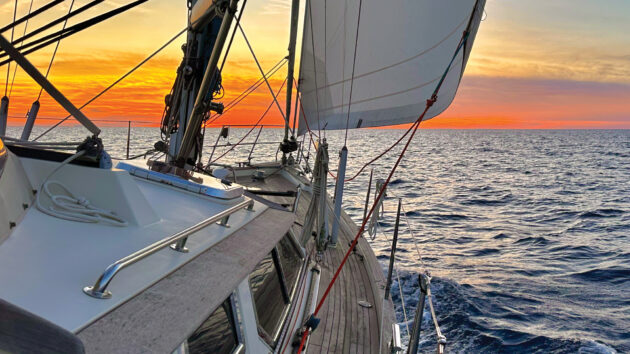
Heading into a dramatic sunset on the overnight passage from Ibiza to Valencia. Photo: James Kenning
Most areas around the islands have reasonable cellular coverage though the high-cliffed coastlines of north Mallorca and Ibiza are notable exceptions. Wherever possible, we exploited the ‘live’ functions of smartphone apps now available to cruisers and we found these invaluable when choosing anchorages.
Beyond Navily’s satellite imagery, details of facilities ashore, community reviews, and ‘comfort’ coded weather forecast, its chat feature enabled us to ask direct questions of yachts geo-tagged in an anchorage of interest. The Noforeignland app also provides similar functionality. We let those already there be our eyes and ears regarding space, swell, and jellyfish swarms! Anchoring is made significantly easier with the (free) Donia app; the boat is GPS-tracked over the accurately mapped areas of Posidonia and is a real help in finding suitable spots to drop the hook. With fines of €1000 issued if either chain or anchor touch the seagrass, it is essential to anchor accurately.
The Posidonia Police patrols are regular and thorough – we witnessed many transgressors falling foul of the law!
‘Must visit’ anchorages will, without doubt, be crowded especially if located close to major holiday destinations.
If wanting to visit Mallorca’s renowned Portals Vells, aim to arrive late afternoon when the day trip boats empty out for their return to Palma. On the flip side, we arrived early morning and thought we had entered just in time to secure the last available spot to drop a hook. We could not believe the mid-afternoon crush of small, medium, and outright large motorboats that later ensued before calm was once again restored to this stunning bay close to sundown!
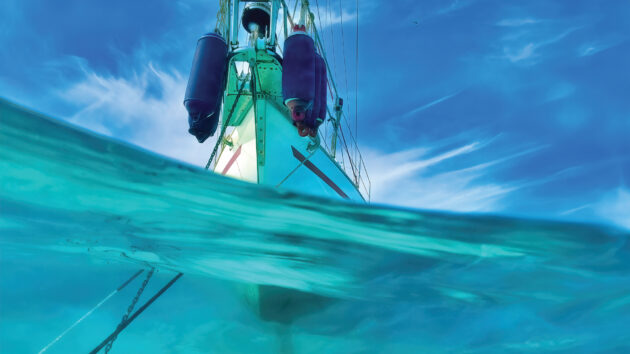
The turquoise waters off Es Trenc are crystal clear. Photo: James Kenning
Another strategy was to look for alternative spots less likely to be plagued with charter boats. In the busier part of the season we escaped the Ibiza party crowd swamping Caribbean-like Espalmador by pushing a little further south to anchor off Formentera’s relatively deserted beach running the length of Ensenada Migjorn. However, do beware of the forecast for both wind and swell if staying overnight.
Cost-effective moorings
For us, cost was a major consideration in choosing our destinations. We especially wanted to visit Mallorca’s harbour town of Andraxt and its superb restaurants but felt priced-out as even a mooring buoy was €100 a night. Instead we booked a buoy in Sant Elm for half the price and took the regular bus service for just €2. We found that there are usually cheap options if you can be flexible and put a little extra effort in. For visiting Palma we anchored in Cala Xinxell where the dinghy could be safely left ashore and a bus stop to town lies just 50m up the hill.
It is vital to take note of weather forecasts when cruising these islands and be prepared to modify plans sometimes at short notice. Arkyla was effectively ‘trapped’ in safe havens for several days at a time as Force 10 winds were forecast (but thankfully never materialised); lightning is also a very real danger in this region (especially close to dawn) and our open-water sails between islands were heavily influenced by high CAPE (Convective Available Potential Energy) forecasts which describe the instability of the atmosphere and the potential updraft strength within a thunderstorm.
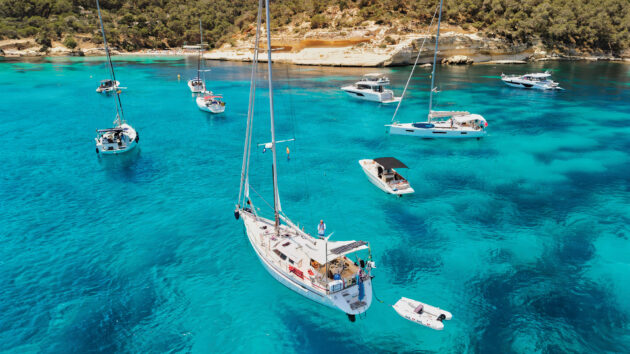
The popularity of Portals Vells waters can make anchoring a stressful experience during the day. Photo: James Kenning
We used the ECMWF model to look 3-4 days out, and AROME for the coming 24 hours. Beware that the topography in the Balearics can make for complex forecasting, so it pays to always be prepared and have a plan B.
Menorca and Ibiza are relatively small, so it is not difficult to relocate to the protected side of each island if winds change. The distances for Mallorca are greater so more thoughts on cruising and protection plans are required. Remember that the Mediterranean can, and does, throw weather tantrums.
In August 2023, hurricane-force winds caused havoc in Mallorca with even large cruise ships were damaged battling the force of the conditions. In 2024, social media exploded with videos of the many boats wrecked off Formentera as a result of a rapidly developing ‘DANA’ (Isolated Depression at High Altitudes) impacting the area – always be on your guard and be prepared to either move or hunker down.
Sóller is the only true port of refuge along the entire north coast of Mallorca, but it is inevitably crowded even out of high season. If a blow is forecast, consider pushing northeast to Port Pollenca which, due to its excellent holding, is considered safe whatever the wind direction – just be sure to keep away from the designated water runway for the fire service seaplane.
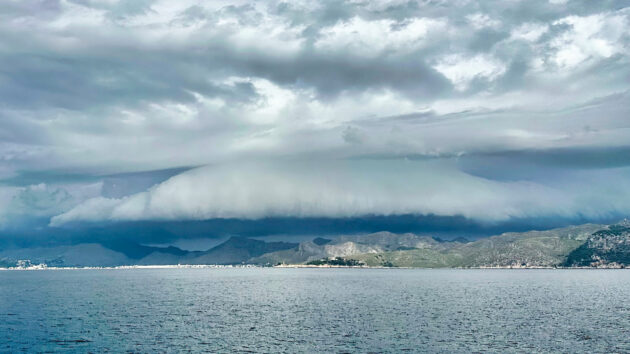
Be prepared for unexpected weather in the Balearics. Photo: James Kenning
I swear I could have handed the pilot his morning cup of coffee as he taxied past Arkyla! Stuck here for a few days, we took the opportunity to visit ‘Old Town’ Pollenca; a beautiful town nestled in the hills, regular buses run from its coastal namesake and it is a trip not to be missed for the views and the restaurants.
If serious weather threatens Menorca, Mahon port authority will lift restrictions on anchoring within the harbour. An alternative is Fornells Bay, which provides exceptional shelter, but don’t be caught here in a northerly!
City pit-stops
Balearic towns and cities are beautiful and packed with history, but berthing in the associated marinas can be busy and expensive. For Mahon, we dropped the hook in the only permissible anchorage of Cala Teulera, taking care to avoid the charted, but unmarked, shallows in the northeast corner. It is a 20-minute dinghy ride to the public jetty for the city but we always made sure to check the weather before leaving the yacht unattended.
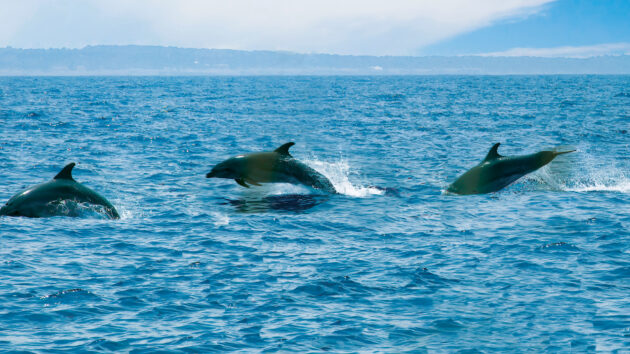
Marine life was noticeably absent during Arkyla’s cruise, but dolphins did occasionally grace us with their presence. Photo: James Kenning
Boats have been known to drag here in the soft mud if the wind rises. We experienced a brutal spell of weather here and, as a front passed over, I spent 90 minutes at the helm motoring on anchor to prevent Arkyla dragging into the shallows. We witnessed multiple yachts collide and at one stage jumped into the dinghy to try to halt the rapid progress of a yacht toward the rocks with its crew sleeping soundly below!
We considered the Balearics really to be the crown jewels of the western Mediterranean. The rewards are many: our personal highlights centred around anchoring in crystal clear turquoise waters, visiting towns brimming with history, dining on great food accompanied with fine wines, and mooring in some of the most spectacular vistas imaginable.
The problems of expense and overcrowding are an issue for the budget-conscious but these are easily overcome with some creative planning and flexible sailing.
This article is a part of our Zhik Spirit of Adventure Awards.
Enjoyed reading this?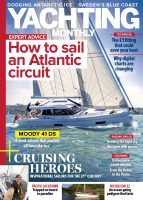
A subscription to Yachting Monthly magazine costs around 40% less than the cover price, so you can save money compared to buying single issues.
Print and digital editions are available through Magazines Direct – where you can also find the latest deals.
YM is packed with information to help you get the most from your time on the water.
-
-
- Take your seamanship to the next level with tips, advice and skills from our experts
- Impartial in-depth reviews of the latest yachts and equipment
- Cruising guides to help you reach those dream destinations
-
Follow us on Facebook, Twitter and Instagram.
Note: We may earn a commission when you buy through links on our site, at no extra cost to you. This doesn’t affect our editorial independence.

